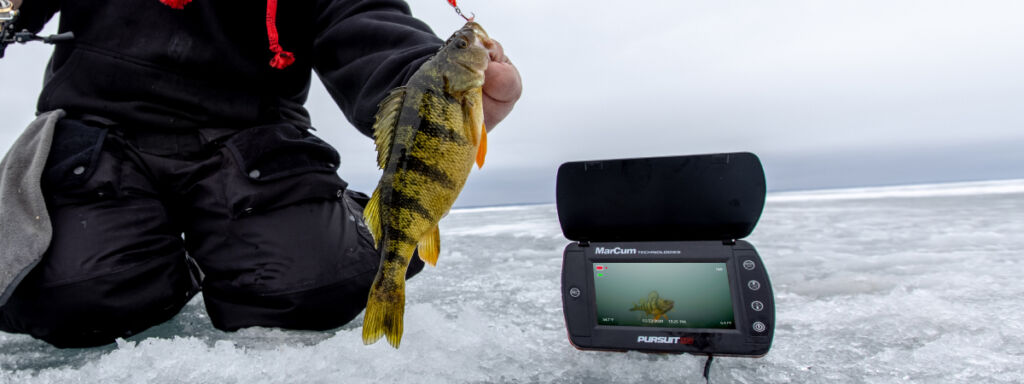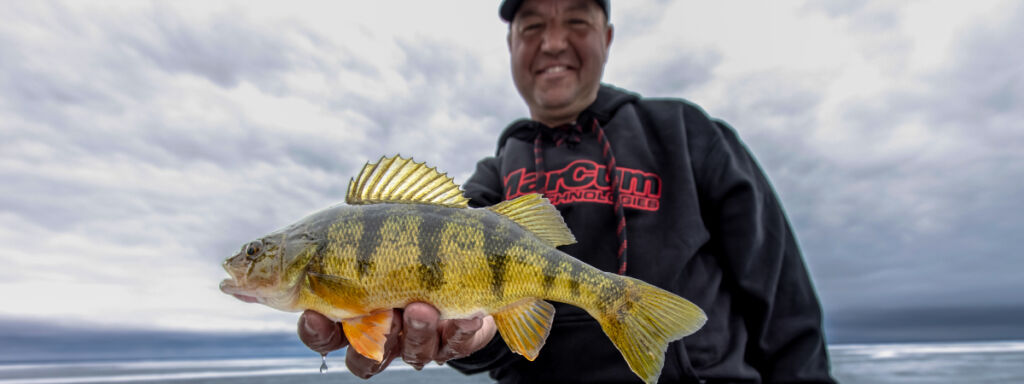Up Your Jumbo Perch Game with
Underwater Cameras
There is just something about seeing it happen with your own eyes. Imagine a jumbo perch roaming through a weed bed in search for an easy meal with its eyes going to and fro looking for its victim. They casually swim the edge of the cover until they catch a glimpse of the bait hovering just above the top of the weeds.
In a split-second decision, they kick on the afterburners and come in hard, with an open mouth. There is no doubt about it, watching a perch eat is fun and effective and something you won’t soon forget.
Yellow perch not only swim in most of the lakes, rivers and reservoirs within the ice belt but they are abundant within them. Known to be a willing biter, it makes them a popular target once the winter temperatures deliver hard water to the region. Not only do they present great opportunities for many hook-sets for ice anglers throughout the day but they also are very tasty. For those reasons, good perch fisheries will draw people from far and wide.
Many of our favorite perch fisheries have clear water, sometimes even leaning to ultra clear. Clear water will lead fish and prey alike into areas of cover to provide refuge and foraging opportunities.

Adult perch feed on various invertebrates, small crayfish, juvenile fish and minnows. All of these food sources will typically seek refuge amongst cover such as weed beds. And naturally weeds need sunlight to grow so this allows you to refine your focus on where to find the perch. In other words, weeds can only grow in shallower water.
Throughout the winter ice fishing season, perch can be found shallow cruising amongst shallow weed beds and along the weedlines of the main lake basin. Perch find their food here but it also serves as a refuge for them as they are on the menu for bass, walleye, pike, muskie and trout.
In the winter months, deeper weeds typically die off making it ideal to target depths of four to maybe twelve feet of water. Start at a good mid depth such as eight feet but be prepared to explore. It may take a little time to find the ideal depth, so don’t be afraid to move around a little at first.
Because you are fishing amongst the weeds, underwater cameras simply give you the best opportunity to be successful. Flashers and depth finders will often pick up the weeds making it hard to see fish and your bait. Underwater cameras allow you to see where the fish are and where your bait is.
WHEN TO GO Perch Fishing
The best time to be out is morning through the afternoon. This gives you maximum light for sight fishing but is also the time when perch are most active.
WHAT SHOULD I USE to perch fish?
There are many lures that will work on perch. Small to medium sized spoons tipped with a minnow head or a wax worm “chandelier” work great for catching eater sized perch. Jigs tipped with soft plastics that have built in action can be used with great success as well. Literally anything that resembles a minnow, bug or invertebrate will work.
Watching them you can see that once they see the bait they kick it in gear to grab before something else does. They make the decision to eat well before they are close to it. This is where using soft-plastics shines because you don’t have to worry about re-baiting when the school is beneath you.

HOW TO SETUP UP the camera ON THE ICE
In clear water, set up your fishing camera about an arm’s length away from the hole you fish from. Simply drill a hole where you are going to fish and then stretch your arms out so that you are five to six feet away. Then drill another hole, this is where the camera is going to go.
Setup the underwater fishing camera so that it is about a foot off bottom or above the weeds for starters. One really nice gadget to have for effectively using the camera is a Marcum camera panner. This allows you to not only set the depth easily but also to rotate the camera in any direction from a distance. They have both a wired and wireless model to suit every angler’s needs.
Once you get it set at the depth you want you’ll need to get it facing the other hole. Underwater cameras that offer directional data such as the Marcum Mission, Pursuit or Quest make it super easy to locate your bait. Simply rotate the camera cord so that the arrow or compass direction is pointed to where you are. Camera systems that do not have directional data just take a little more time to get it in the correct position.
Once you get everything situated, let the camera do the talking. Pay attention to how the fish behave, where they come from and where they go to. If you don’t see any activity then simply move. Once you do this a few times you will get the hang of how to set up everything. Once you get set up in a good spot, you should be good to go.
Shallow water perch fishing can be addicting. It’s action-oriented, visual and plenty of fun. Make sure you give it a try this winter and you’ll be back for more.










